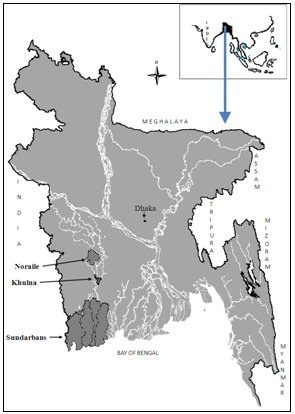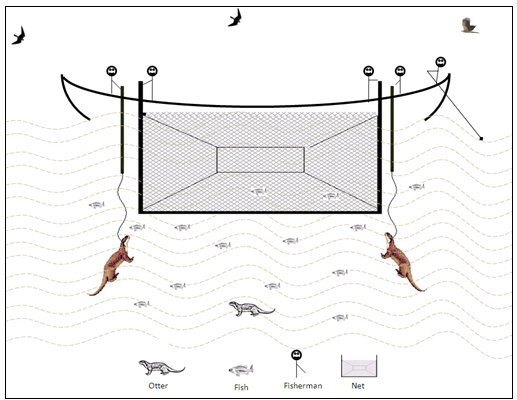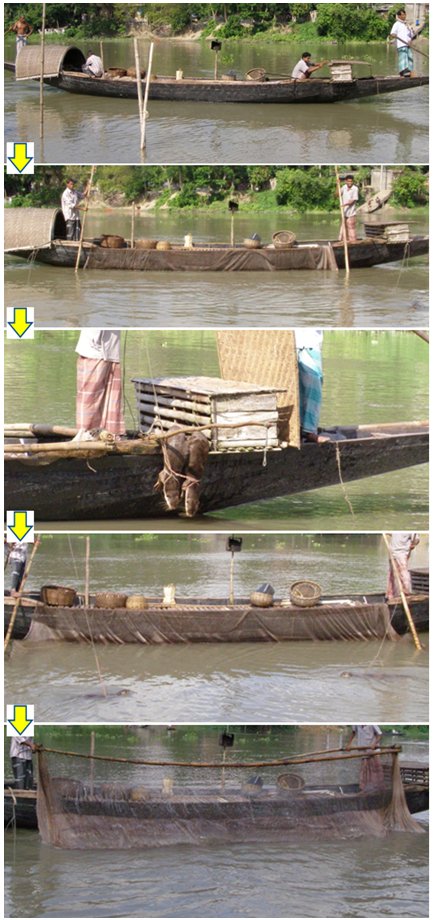IUCN/SSC Otter Specialist Group Bulletin

|
©IUCN/SCC Otter Specialist Group Volume 28A Proceedings Xth International Otter Colloquium, Hwacheon, South Korea Citation: Feeroz, M.M., Begum, S. and Hasan, M. K. (2011) Fishing with Otters: a Traditional Conservation Practice in Bangladesh. Proceedings of Xth International Otter Colloquium, IUCN Otter Spec. Group Bull. 28A: 14 - 21 Fishing with Otters: a Traditional Conservation Practice in Bangladesh Mohammed Mostafa Feeroz1, Sajeda Begum1 and Md. Kamrul Hasan1
1
Dept. of Zoology, Jahangirnagar University, Savar-1342, Dhaka, Bangladesh e-mail: feerozmm@yahoo.com |
 |
|
Abstract: Fishing with otters has been practiced in Bangladesh for the last two hundred years. This traditional practice plays an important role in otter conservation in Bangladesh. Among the three species of otters found in Bangladesh, only Lutra perspicillata is currently used for fishing by the fishermen in and around the Sundarbans. Noraile and Khulna districts, near the Sundarbans, are the only districts in the country where this species is bred in captivity, tamed, and used for fishing by the fishermen. These fishermen are completely dependent on this technique for their livelihood. These tamed otters are used for fishing in rivers inside the Sundarbans during winter and pre-monsoon. Fishing occurs outside the Sundarbans only during monsoon. The whole fishing system is unique, involving three people, a boat, a net, two adult tamed otters, and an immature trainee otter. The tamed otters generally do not catch fish by themselves during fishing rather they chase fish towards a special fishing net placed in the water away from the boat. Otters start driving fish to the net from different directions and when they come close to the net, the fishermen pull the net into the boat. Fishing with otters occurs at night, mostly between 2100h and 0500h. Fish are captured during 8 to 12 periods by each fishing group per night. The total nightly weight of captured fish varies from 4 to 12 kg. We recorded 176 otters of different age and sex classes in captivity belonging to 46 fishermen groups in two districts. Among these, 138 adult otters are actively involved in fishing. The remaining animals are infants, juveniles, or very old. These otters breed successfully in captivity and maintain their population. Approximately 300 people are directly involved in this fishing technique and another 2,000 people indirectly depend on this method of fishing for their livelihood. This species of otter is conserved traditionally both in captivity and in the wild in this area. |
| Keywords: Smooth-coated otter, Lutra perspicillata, fishing with otter,traditional conservation |
| Française | Español |
INTRODUCTION
Bangladesh is a multi-cultural and multi-religious country with limited resources. All these cultures and religions have an enormous impact on the conservation of biodiversity in the country. Both Islam and Hinduism encourage plant and animal conservation. The remaining population of both the Common Langur (Semnopithecus entellus) and the Bostami Turtle (Aspideretes nigricans) are still found in the country only because of these religious beliefs. But increased population pressure with the demand for fuel wood has been eliminating the vegetal covers and forests of the country. As a result the population of wild animals has been decreasing at an alarming rate. It is estimated that we have lost about 8% of the mammalian species of Bangladesh during the last 100 years or so and at present, 36% of mammals are facing different level of threats in the country (IUCN - Bangladesh, 2000). However, 25 species of plants and 32 species of animals are still traditionally conserved by the people in the country (Mitra and Kabir. 2009). While fishing with otters, a traditional fishing technique, is nearly eliminated from different parts of south Asia, people still maintain this practice in some small villages of Bangladesh. This fishing technique plays a vital role in conserving otters in Bangladesh. In this paper, we discuss this unique fishing technique, the socio-economic condition of fishermen who use otters for fishing, and the future of these captive otters.
METHODS
We selected the Khulna and Noraile districts in southwestern Bangladesh for our study (Figure 1). These are the nearest districts of the Sundarbans, where the largest tamed otter populations are found. We surveyed fishermen in 12 villages during eight surveys between February 2003 and January 2005. Five of the eight survey trips took place during the winter season (October to February), one survey trip in pre-monsoon (March to June) and two survey trips during the monsoon season (July to September). The field surveys lasted 3-5 days each. In each village, we collected data on the total number, age and sex class of the tamed fishing otters as well as information about the training and husbandry practices used for these valuable animals. Additionally, data were collected on the methods and materials used during the fishing trips (e.g., boat size and capacity, fishing techniques, etc). Finally, a standardized data sheet was used for collecting information on the socio-economic conditions of the fishermen who use otters for fishing.
 |
| Figure 1. Map of Bangladesh showing otter fishing sites. (click for larger version) |
RESULTS AND DISCUSSION
We interviewed 47 adult fishermen during this study. While fishing with otters occurred in five adjacent districts of the Sundarbans as recently as a decade ago, it is now practiced by some few fishermen only in the Sundarbans and in the two adjacent districts Naraile and Khulna (Figure.1). The same single fishing technique is used by the fishermen in all these areas. Using the otter-assisted fishing technique, several fishing attempts can be made within an hour. By using the trained otters, the fishermen reduce their physical energy expenditure and are able to capture more fish in one night than they would if they used any of the other local fishing techniques.
Fisherman community: The fisherman community known as malo jele is involved in fishing with otters. Approximately 300 people from twelve villages in the Khulna and Noraile districts are directly involved in fishing with otters and another 2,000 people indirectly depend on this process for their livelihood. These fishermen capture fish in two areas. During pre-monsoon and winter they captured fish in the Sundarbans. During the rest of the year they fish in the river Chitra and adjacent rivers of the Norail District. These fishermen are suffering from poor financial situations. They have no land for cultivation and fishing with otters is their only source of income. Most of these fishermen are illiterate. The new generations of the community who are engaged in education are not willing to be fishermen like their parents. As a result the malo jale population is gradually decreasing.
Captive otter: Fishing with otters has decreased drastically during the last decade. A decade ago both Lutra perspicillata and Lutra lutra were used for fishing. At present only Lutra perspicillata is used for fishing in Bangladesh. We recorded 176 otters of different age and sex classes in captivity belonging to 46 fishermen groups. Among these, 138 were adult otters actively involved in fishing, the remaining animals were infants, juveniles, or very old.
Food supply for trained otters: The types of food provided by the fishermen for these otters depended on the season and availability. Fifty-eight species of fish, one species of frog (Hoplobatrachus tigerinus) and several species of crabs were recorded as food for these captive otters. Occasionally non-poisonous snakes, eel, and small turtles, which were trapped in fishing nets, were given to these otters too. An average of 1.1 kg (range 1–2.3 kg) of food was given to each otter during the moonson (July-September) and winter (October-February) seasons, when fish were readily available. In contrast, only 500–600 g of food was given to each otter during the pre-monsoon (March-June). In addition to the provisioning given by the fishermen, the otters were able to catch their own fish while working.
Fishing training: The fishermen collect the parent stock of otters from the wild or from other fishermen who have captive otter populations. By breeding these otters in captivity the fishermen increase their captive stock. The fishermen use the juvenile otters with the trained adult otters during fishing. In each fishing team, they use three otters: two adult trained otters and one juvenile otter as trainee. In the daytime, the fishermen throw fishes in the water, uttering a sound like dhor-dhor-dhor (“catch, catch, catch” in English) and make the juvenile chase it and bring the fish to them. In this way, the juvenile develops a tendency to chase anything throughout the water when they hear this sound. During fishing, the fishermen release this juvenile with the trained, adult otters and utter the same sound, dhor-dhor-dhor. The juvenile swims around throughout the water and chases fish towards the fishing net. Juvenile otters begin their training after the age of two years and typically are fully trained within 5 to 6 months.
Fishing technique: This traditional fishing technique is different from other general fishing methods. Each fishing group is composed of one fishing boat, three to five fishermen, one special fishing net, and three otters. The length of the fishing boats varied from 11m to 15m and width varied from 1.3m to 2.1m. The bottom of the boats are convex. Carrying capacity of these boat varied from 2,000 kg to 4,800 kg (mean=2970 kg ± 256.7 kg , n=18). The net used for this fishing is rectangular in size and varied from 6m x 5m to 12m x 6m. The mesh size varied from 1cm to 2.5cm. Fishing with otters occurred mostly at night, between 2100h and 0500h inside the Sundarbans. Sometimes the fishermen used their otters to fish during the day during the high tide outside the Sundarbans. Fish were captured during 8 to 12 periods by each fishing group per night.
During fishing, the boat was placed in the middle of the river. Two fishermen sink the net straight into the water using two bamboo poles attached on either side of the net and hold it. Two adult otters are each tied to a separate rope that is fixed to a stick held by the fishermen on either side of the net (Figure 2). The length of the otter sticks varied from 1.5 to 2.5m and the length of the rope varied from 1 to 1.5m. Another otter (typically a juvenile) was set free to move in front of the net. This arrangement created a rectangular fishing area of about 40 square meter formed by the three otters on one side and the fishing net on the other. Once the otters and the net are in place, the fisherman excites the otters by uttering the typical sound of “dhor-dhor-dhor” and by pulling the stick in and around the sunken net. The otters start driving fish to the net from different directions and when the fish come close to the net, the fishermen pull the net into the boat (Figure 3).
Socioeconomic condition of fisherman: For their livelihood, these fishermen are completely dependent on fishing with otters. They do not engage in agriculture, farming, or any other type of business. As a result without otter fishing each day, it becomes extremely difficult for them to maintain their day to day basic requirements. Unfortunately, during heavy rain, floods, or storms they are not able to fish and consequently face an economic crisis.
The weight of captured fish varied from 4 to 12 kg in one night. Several species of fish are captured in the rivers outside the Sundarbans. But shrimp are mainly captured inside the Sundarbans. The quantity of fish captured in one night by otter fishing technique is more than any other local fishing technique. The weight of captured shrimp varied from 2 to 7 kg in one night. Capturing shrimp in the Sundarbans is more profitable than capturing any other type of fish. All members of a fishing group share their daily earnings.
Apart from direct involvement with this traditional fishing, many more people indirectly benefit from this trade through transport, net making, boat building, etc. This technique of fishing is very profitable compared to other local fishing techniques. This is because it requires less manpower, needs less physical exertion from the fishermen, is frequently repeatable, and requires minimal financial investment.
Unfortunately, this traditional fishing practice is now in danger of elimination. Only a decade ago more than five hundred otters were used for fishing and approximately 5000 people were directly or indirectly involved in five districts (Kashem, 1997). Several factors are causing the rapid decline of this traditional practice. These include the poor financial situation of the otter fishermen. These fishermen always need significant financial support when they are fishing inside the Sundarbans for a period of about four months, and most of them are not able to manage this financial commitment themselves. Therefore, they have to depend on money lenders who charge a high interest rate. Moreover, this community of malo jele has a minority status. They suffer from many kinds of social problems, such as the inability to acquire land, lack of social justice and support, and a constant threat of violence and discrimination. All these social factors are contributing to the decline of this traditional fishing practice. Additionally, fish availability is drastically decreasing because of water pollution by the waste from plastic, cotton dyeing and other industries, over sedimentation in the river, and indiscriminate fishing by other fishermen throughout the year. Apart from these problems, the fishermen have to compete with many other local fishermen for fishing grounds, especially with those groups that are involved in mechanical fishing techniques. Conflict with the local government authority over taxes and fishing permission, robbery in Sundarban areas, diseases both in fishermen and in otters, high cost of basic needs, and increasing population pressure also are influencing the fishermen to quit this practice.
Because of the involvement of the fisherman with the otters, people of this area traditionally conserve this species in the wild. It was found that the breeding potential of these tamed otters in captivity is more than 90% (Feeroz et al., 2007). It was also found that these captive bred populations are able to survive in the wild. Thus this traditional practice can play a vital role in ex-situ conservation as well as in in-situ conservation through reintroduction and rehabilitation of this species. Direct intervention of the government, as well as involvement of national and international research organizations can play a vital role in protecting one of the last remaining traditional conservation practices in Bangladesh.
REFERENCES
Kashem, T. (1997). Ecology and behavior of otters of Bangladesh. Unpublished M.Sc. Thesis. Jahangirnagar University, Bangladesh.
Feeroz, M.M., Aziz, M.A., Thanchanga, P.A. (2007). Breeding activities of Lutra perspicillata in Bangladesh. IUCN OSG Bull. 28A, this issue.
IUCN Bangladesh (2000). Red Book of Threatened Mammals of Bangladesh. IUCN-The World Conservation Union. 294 pp + xii.
Mitra, B.B., Kabir, M.M. (2009). Studies on the conservation oriented taboos and totem in the ethnic groups of greater Mymensingh region of Bangladesh. Bangladesh J. Life Sci. 21(2), 1-8.
Résumé : Pêcher Avec Des Loutres : Methode Traditionnelle De Conservation Au Bangladesh
La pêche à l‘aide de loutres est pratiquée au Bangladesh depuis deux siècles. Cette pratique traditionnelle joue un rôle important dans la protection de la loutre au Bangladesh. Parmi les trois espèces de loutres présentes, seule Lutra perspicillata est actuellement utilisée par les pêcheurs aux Sundarbans et dans les alentours. Les districts de Noraile et de Khulna, sont les seuls lieux du pays où cette espèce est élevée en captivité, apprivoisée, et utilisée pour la pêche par les pêcheurs. Ces pêcheurs sont complètement dépendants de cette technique pour leur subsistance. Ces loutres apprivoisées sont utilisées pour pêcher dans les rivières des Sundarbans pendant l'hiver et la pré-mousson et en dehors uniquement pendant la mousson. Le système de pêche dans son ensemble est unique impliquant : trois personnes, un bateau, un filet, deux loutres adultes apprivoisées et une loutre immature en apprentissage. Les loutres apprivoisées ne sont généralement pas capables d’attraper les poissons elles mêmes mais chassent plutôt les poissons en direction d‘un filet de pêche spécial placé loin du bateau. Les loutres poussent le poisson vers le filet depuis plusieurs directions et lorsqu‘elles arrivent près du filet, les pêcheurs le remontent rapidement dans le bateau. La pêche a lieu de nuit, surtout entre 21h et 05h. Les poissons sont capturés au cours de 8 à 12 sessions de pêche par nuit et par groupes de pêcheurs. Le poids total des poissons capturés durant la nuit varie de 4 à 12 kg. En captivité, nous avons enregistré 176 loutres d‘âges et de sexes différents appartenant à 46 groupes de pêcheurs des deux districts. Parmi elles, 138 loutres adultes sont activement impliquées dans la pêche tandis que les autres animaux sont soit des loutrons, de jeunes immatures ou de vieux individus. Ces loutres se reproduisent avec succès permettant le maintien de l‘effectif captifs. Environ 300 personnes sont directement impliquées dans cette technique de pêche et près de 2 000 personnes dépendent indirectement de cette méthode pour leur subsistance. Cette espèce est finalement conservée traditionnellement en captivité et à l'état sauvage dans ce secteur géographique.
Revenez au dessus
Resumen: Pescando con Nutrias: una :Práctica Tradicional de Conservación en Bangladesh
La pesca con nuterias ha sido practicada en Bangladesh durante los últimos doscientos años. Esta práctica tradicional juega un rol de importancia en la conservación de las nutrias en Bangladesh. De entre las tres especies de nutrias que habitan Bangladesh, solamente Lutra perspicillata es actualmente utilizada para la pesca por los pescadores en el delta del Sundarbans. Los distritos de Noraile and Khulna, cerca del Sundarbans, son los únicos distritos en el país donde estas especies son críadas en cautiverio, domesticadas y utilizadas para la pesca. Estos pescadores dependen completamente de esta técnica para su subsistencia. Las nutrias domesticadas son utilizadas para la pesca dentro del Sundarbans durante las epocas de invierno y del pre-mosoon. Pesca por fuera del Sundarbans ocurre solamente durnate el monsoon. El sistema de pesca es único y require de tres personas, un bote, una red, dos nutrias domesticadas y una nutria joven para entrenamiento. Las nutrias domesticadas generalmente no atrapan los peces durante la pesca, los persiguen y dirigen hacia una red de pesca ubicada en el agua a una cierta distancia del bote. Las nutrias conducen los peces hacia la red desde diferentes direcciones y cuando estos están lo suficientemente cerca, el pescador tira de la red hacia el bote. La pesca con nutrias ocurre principalmente en la noche, generalmente entre las 2100h y las 0500h. Las capturas se realizan entre 8 y 12 ciclos por cada grupo de pesca por noche. El total en peso de captura por noche varía entre 4 y 12 Kg. Hemos registrado 176 nutrias en cautiverio de differentes edades y géneros, pertenecientes a 46 grupos de pescadores en los dos distritos. 138 adultos de entre ellos están participando activamente de la pesca. Los animales restantes are menores, jovenes o muy viejos. Estas nutrias se crían con éxito en cutiverio y mantienen su población. Aproximadamente 300 personas están directamente relacionadas con esta técnica de pesca, mientras que otras 2,000 personas dependen indirectamente de ella para su sostenimiento. Esta especie de nutria es tradicionalmente conservada en cautiverio y en libertad en esta area.
Vuelva a la tapa

